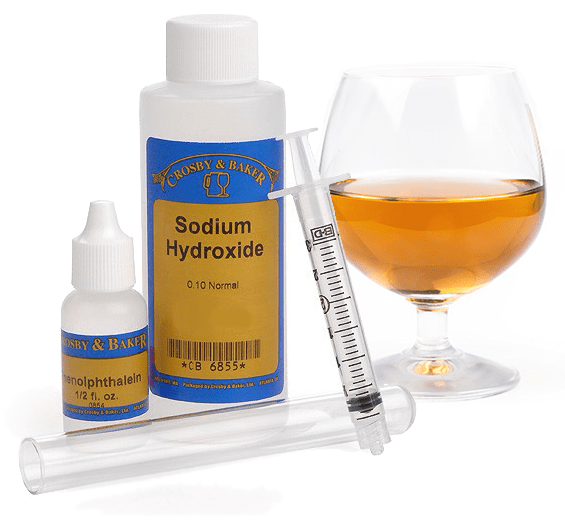 Hi everyone! I hope all your home winemaking adventures are going well!
Hi everyone! I hope all your home winemaking adventures are going well!
For me, I have to admit I’m somewhat confused… It has to do with mead acidity.
Backing up a second, one thing that did happen this week was that I got the shipment I ordered from ECKraus. I ordered several items, including a new floating thermometer to replace the “sticker” one that I had previously, the Pressurized Wine Filter system, a couple of filter pads to fit in the filter system I purchased, a longer racking cane from my slightly taller carboy, and finally the Acid Test Kit.
Why am I confused? Well, it’s related to the results of the Acid Test Kit when testing my mead. I wanted to test it to see if there was something off about the acid levels, since the specific gravity has stopped at 1.002 (still that value when I tested the acid). I figured I’d check the acid levels of the mead to see if maybe that needed some adjustment before moving forward, or if it’s just simple matter of jump starting any remaining yeasts.
Well, the results of the acid test showed that my mead has 0.725% tartaric acid and 4.64ppt sulfuric acid. I calculated the TA (titratable acidity) to be 4.35g/L, based on instructions found online.
On the acid test kit instructions, it gives recommendations for different types of wine in terms of what the % tartaric and ppt sulfuric acid should be. For white grape wine, they recommend a range of 0.65-0.75 tartaric and 4.2-4.9 sulfuric. For red grape wine, they recommend a range of 0.60-0.65 tartaric and 3.9-4.2 sulfuric. Finally, for fruit wine, they recommend a range of 0.55-0.65 tartaric and 3.6-4.2 sulfuric acid.
Here’s where my confusion lies:
I’m not making white, red, or fruit wines. I’m making mead! What in the world are the recommended acid ranges of tartaric acid and sulfuric acid for mead? Do I count it as a “white wine” because that’s what it most closely resembles? No, that can’t be right. It’s honey, no grapes! Different chemistry.
Well, after a nearly fruitless search through Google, I could barely find anything that even remotely hinted at what mead acidity levels I should be looking for. After a while, I did find a page that discussed how measuring titratable acidity in mead was actually often highly inaccurate and not a trusted way to determine acid levels in honey wine. It is basically related to the types of sugar found in honey versus the types of sugar found in grapes or other fruits (namely: gluconic acid/gluconolactone). Supposedly, the sugars and other compounds in the mead react much differently than those in grape or fruit wine, thus significantly skewing the true results.
So, does this mean I just wasted my time using the acid test kit to test my mead’s acidity? Well, I think it depends on how you look at it. It might not be the best measure for acid in mead, but at least I got to practice how to perform the test! I’m going to have to dig a little deeper on this, I think!
————————————————————————————————————-
 My name is Leigh Erwin, and I am a brand-spankin’ new home winemaker! E. C. Kraus has asked me to share with you my journey from a first-time dabbler to an accomplished home winemaker. From time to time I’ll be checking in with this blog and reporting my experience with you: the good, bad — and the ugly.
My name is Leigh Erwin, and I am a brand-spankin’ new home winemaker! E. C. Kraus has asked me to share with you my journey from a first-time dabbler to an accomplished home winemaker. From time to time I’ll be checking in with this blog and reporting my experience with you: the good, bad — and the ugly.

We make mead all the time and never check for acid content. Each batch so far at least has turned out beautiful. Its just honey, water, and yeast so no worries about skins, sweetness etc. Of couse start with good honey (which I guess pertains to any wine